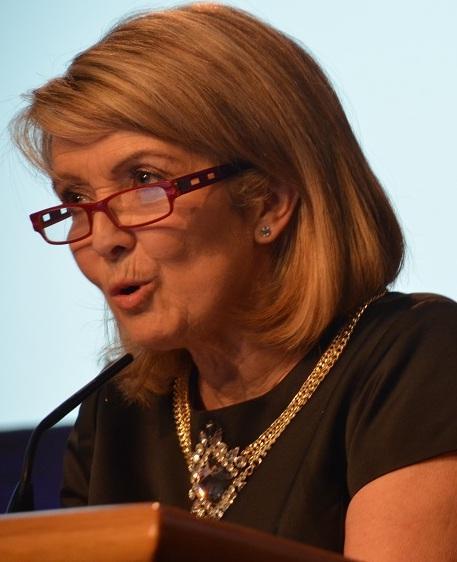

Interview with Dr Marie Keenan
On the women’s rights and the MeToo movements and the public recognition of making restorative justice accessible as service for survivors of sexual violence. A discussion for the International Women's Day 2020.
Dr Marie Keenan is an internationally recognised expert in two very sensitive and extensively discussed justice related matters: the applications of restorative justice in cases of sexual violence, and child sexual abuse committed within the realm of the Catholic church. In this interview conducted on the occasion of the International Women’s Day we focused on first mentioned area of her expertise. We were interested in how she thinks about women’s rights and the MeToo movements and the public recognition of making restorative justice accessible as service for survivors of sexual violence.
When advocating for such a service, Marie Keenan often collaborates with Ailbhe Griffith a restorative justice advocate, who we also interviewed for this International Woman’s Day. Both of them will be among the keynote speakers at our upcoming international conference in Sassari. She also contributed to The Meeting film, based on Ailbhe Griffith's true story, which will be screened in Sassari. The conference will be a good opportunity to listen to them in person, watch their movie, and to discuss questions evoked by their message.

In your opinion can restorative justice help to restore the imbalance between women and men in society?
From my perspective restorative justice is not specifically about restoring balance in relationship between men and women – that is a much bigger social, economic, legal and political project. Restorative justice as I see it is more about empowering victims of crime when the crime has had the effect of disempowering them, irrespective of the gender of the victim or the offender.
What is your opinion about the women’ rights movement bringing public attention to gender-based violence?
Without the women’s movement I don’t believe we would have any attention paid to the issue of gender-based violence. It is through the work of the feminist movement to begin with, rape crisis centres and domestic violence services and lobby groups with the help of investigative journalists and the media that we have gotten any attention for these crimes against women and children. Having said that in my area of expertise of sexual violence, domestic abuse and coercive control I am concerned about all victims of such crime irrespective of gender. We know from research and clinical practice that male children as well as female children experience the suffering and harm associated with child sexual abuse. In relation to adult rape and sexual violence and domestic abuse/coercive control while the majority of these crimes largely affect adult females and are perpetrated by adolescent or adult males, nonetheless we cannot ignore the male victims who suffer from the effects of these crimes too.
In restorative justice we tend to aim for bringing back the conflict to the people involved in it, focusing on the relational barriers among people and their own personal stories. Whereas the Metoo movement aims to bring personal cases to the public sphere and often draws generalised conclusions from them. Do you think there can be a common ground between these two seemingly contradictory purposes?
I will focus my answers here on sexual crime and domestic abuse or coercive control. These crimes are both private/personal and public/political and we must not lose sight of either dimension in my view. If we confine our attention to the personal /private sphere of these crimes and focus our attention only on the immediate people involved and their relational connections, the broader dimensions of culture, socialisation, inequality, injustice, and the gender dividend - all the factors that are part of the context in which these problems arise and are addressed - are not countenanced or considered sufficiently. However, if we focus only on the public and political aspects of these crimes then processes designed to help with individual healing, personal storytelling and personal empowerment are not given sufficient attention. Sexual and domestic violence and abuse are both private/personal and public/political and require attention at both levels. Victims of sexual and domestic violence and abuse have suffered for far too long from an approach that saw their problems as merely ‘private’ – nothing to do with ‘me’. Restorative justice must not contribute to this thinking. The women’s movement moved these crimes from the private/personal sphere to the public/political one. Restorative justice must contribute to debate and consideration of the public/political dimension of these problems too. We are well placed to do this with our community emphasis. This part of our mission however needs further theoretical and clinical elaboration.
Research says that about 5% of cases of sexual violence reach the criminal justice system, often because such violence occurred within a relational context. In what way restorative justice can offer a different form of justice for those ones who do not wish to initiate a criminal justice procedure? How can those cases be identified and reached to offer a restorative justice programme?
A minority of sexual violence cases are reported (for a variety of reasons) and an even smaller number of cases result in a conviction. Internationally this problem is known for its high attrition rates. The reasons for this are multiple – wider than your suggestion of occurring within a relational context - and beyond the context of this short answer – but I would refer interested listeners and readers to the very comprehensive Gillen Reports conducted by Sir John Gillen in Northern Ireland on the factors involved in securing justice for victims of sexual crime. To get to the role of restorative justice in this I am certainly of the view that the time has come that we can no longer deny victims of sexual crime restorative justice, as an additional justice mechanism for them. I do not advocate restorative justice as an alternative to criminal justice unless for those victims who do not wish to go the criminal justice route – but as an additional justice mechanism for any victims who want it. We know of course for the majority of victims because of the high attrition rates involved in sexual crime, restorative justice were it to be available for victims might be the only justice they receive.
A few points here however are very important to emphasise:
First, restorative justice following sexual violence must in my view be a victim-initiated process. We are very used in youth offending and other types of crime to working with offender-initiated restorative justice. Restorative justice following sexual or domestic violence and coercive control involves an entirely different lens: victim initiated rather than offender initiated or focused.
Second, while the dialogue aspect of restorative justice following sexual violence is often the key to empowering victims, and the focus on ‘Agreements’ less so in many cases, there may be a role for having ‘Agreements’ in place also in restorative justice cases that have not had a criminal justice outcome, and such agreements could include such considerations as the offender going for therapy etc. Project Restore in New Zealand use such an approach effectively from what we can see.
"Dehumanisation makes no sense if we want to help individuals who have acted in an inhumane manner..."
It is common to characterise people who committed sexual abuses as monsters. Furthermore, one who attempts to talk about them in more subtle terms and tries to listen to their part of the story can be easily denounced as someone who does not respect the victims. How do you see this?
Because of the impact of sexual crime perpetrators are often seen as monsters and spoken about in disrespectful terms. This vilifies them further and drives them underground. I understand completely the detestation of and revulsion for the harm that the perpetrator has inflicted. I also understand how this detestation and revulsion can become located at the personhood of the individual. However, my belief is that disrespect as an approach never works if we want to help people change from disrespectful to respectful ways of behaving and living; dehumanisation makes no sense if we want to help individuals who have acted in an inhumane manner to act in more respectful and sensitive ways to other human beings. Therefore while ‘discharging’ anger is understandable for the impact of such degradation and hurt as is inflicted on victims of sexual crime, adopting this as a ‘stance’ is not useful – actually it is unhelpful to the mission.
What were your main challenges you had to face when you first proposed the application of restorative justice in cases of serious harm, such as sexual violence?
Gaining social and professional acceptance for the idea continues to be a challenge. However, research and writing up the case examples is important here. This is why Ailbhe also devotes her precious time to this in helping other victims who are suffering to know of the existence of restorative justice and the possibilities of restorative justice to help them in the aftermath of sexual crime.
Do you see it becoming more accepted today?
Yes, slowly. We can no longer deny this service to victims and offenders. However, our job is to make the process as physically, procedurally and legally safe as humanly possible. The 2012 EU Victims’ Directive has helped the case enormously too, as well as Council of Europe recommendations, and research of course. However, more outcome research is necessary and we must continue to bed in services in legislation in some cases, but with adequate statutory funding in the main.
"Our job is to make the process as physically, procedurally and legally safe as humanly possible."
In your eyes, what would be required to make restorative justice more widely accessible in cases of serious harm?
In some cases legislation, political will; in all cases adequate statutory funding and service provision as a legitimate arm of state policy and service provision. Estelle Zinsstag and I found that where services close it is usually because of inadequate funding or key passionate individuals leaving to take up other employment. This situation thus tells us that for sustainability and longevity of service provision, services must be well embedded in the state’s repertoire of responses to sexual violence and not dependent on passionate individuals with inadequate funding who drive the process.
What do you aim to achieve by giving common presentations with Ailbhe Griffith? What is the impact of her presence on your message?
Ailbhe had such a good outcome from her restorative meeting, having had years of unnecessary suffering by being denied such a service, as have other men and women with whom I have been involved, we want to try to spread the message: restorative justice might have something to offer victims who would like this opportunity and it has something to offer offenders who want to do something honourable in the face of having done something so dishonourable to another human being. The job of facilitators is to let the victim decide, ask the offender if he is willing and make the process as safe as humanly possible.
Published on 8 March 2020.

